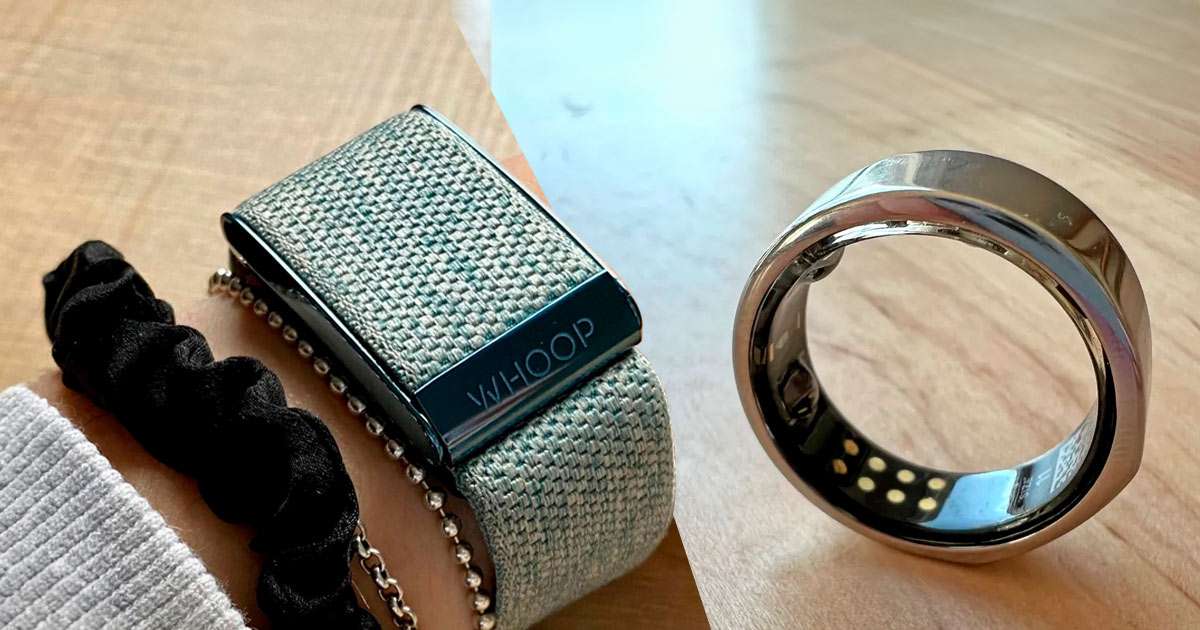Whoop vs. Oura: Which Sleep Tracker is More Efficient?

An ongoing online debate among health and wellness enthusiasts centers on determining the superior wearable device for sleep, activity, and recovery tracking, with particular focus on the Oura smart ring and the Whoop fitness band. Despite differing in form factor, both devices monitor similar metrics, including sleep stages, heart rate, and calorie burn.
This Whoop vs. Oura review thoroughly compares these wearables, evaluating their efficacy in sleep monitoring, activity tracking, and recovery tracking. Additionally, design and pricing considerations will be addressed to conclude this comparison. Let’s begin!.
Features & Functionalities
If you’re curious about what sets these devices apart and how they differ, you’ll find that while Whoop and Oura may appear different externally, they share many similarities in their capabilities. Both offer features to monitor sleep, activity levels, and recovery. To better understand these wearables, let’s explore their functionality and how they provide insights into your health and well-being.
Sleep Monitoring
Oura specializes in tracking sleep, which has led to its success in the wearable tech industry. It monitors various sleep factors such as duration, bedtime, resting heart rate, sleep stages, and how quickly you fall asleep, providing detailed insights into sleep patterns. Oura calculates sleep efficiency and restfulness, helping users identify areas to improve their nightly rest. It assigns a sleep score from 0 to 100, with scores above 85 indicating optimal sleep, 70 being good, and scores below suggesting potential sleep issues. The third-generation Oura ring has upgraded sleep tracking capabilities, making it particularly beneficial for individuals with insomnia.
Whoop’s sleep tracking is similar to Oura’s, monitoring respiratory rate, heart rate, disturbances, and movement patterns, like the smart ring. While Oura uses sleep scores, Whoop sets targets to assist users in achieving performance goals, with 100% for optimal performance, 85% for adequate recovery sleep, and 70% for basic functionality. Unlike Oura, Whoop also tracks ambient temperature and electrodermal activity (EDA).
Using ambient temperature for health and fitness management may have limitations, affecting sleep tracking and recovery assessments. Despite this, Whoop calculates your baseline sleep need considering recent strain, sleep debt, and naps. However, Oura is preferred over Whoop for its greater accuracy.
Whoop band vs Oura ring Activity Tracking
The Oura ring offers basic activity tracking, recognizing over 50 activities with its Automatic Activity Detection (AAD) feature, including HIIT, core exercises, and household chores. However, its accuracy is inconsistent and may misidentify activities, requiring manual tagging to prevent future errors. Notably, detailed data on weightlifting and elevation activities is lacking. Overall, while suitable for basic tracking, Oura’s performance in this area could be improved with more activity options and enhanced AAD functionality.
Whoop stands out in activity tracking, designed specifically for this purpose, offering a holistic approach with its ‘Strain’ metric assessing physical and mental exertion across various activities like workouts and daily tasks. Strain scores range from 0 to 21, reflecting different levels of stress and activity. Both Whoop and Oura offer weekly trends via their apps, detailing daily and weekly activities, average heart rate, and calorie burn. However, for fitness enthusiasts, Whoop is preferred for its comprehensive activity tracking features.
Oura ring vs Whoop 4.0 Recovery Tracking
Both Oura and Whoop provide useful recovery tracking features. Oura assesses readiness for daily tasks with a ‘Readiness’ score ranging up to 100, which reflects recovery status. This score considers factors like resting heart rate, body temperature, the previous day’s activity, sleep balance, and heart rate variability, averaged over a 14-day period to compare recent activity levels with long-term averages.
Oura considers a score above 85 as optimal for readiness, signaling preparedness for tasks, while 70–85 is seen as good. Scores below 70 prompt Oura to recommend adjustments for recovery, such as napping, light activities, or meditation. Overall, Oura’s recovery tracking offers helpful daily insights.
Whoop assesses recovery using key biometrics like HRV, RHR, and sleep quality, offering a score from 0–100% with color codes (green, yellow, and red) indicating recovery status. Its rest suggestions, especially during illness or intense workouts, are usually accurate. In contrast, Oura evaluates recovery based on sleep and activity balance, which is considered superior, potentially due to its ring form factor providing more accurate HRV readings. If tracking recovery and managing exercise intensity are your main goals, Whoop is a dependable option.
Whoop vs. Oura App & Analytics
Both Oura and Whoop offer mobile apps for Android and iOS devices, compatible with various third-party apps. They effectively collect data and provide extensive analytics, offering a diverse range of metrics and insights. While Oura tends to be more accurate in metrics like heart rate due to its form factor, both devices feature robust data collection and analytics, including weekly and monthly trend analysis, accessible through their mobile apps. Ultimately, your choice between the two should be based on your specific needs and intended use of the device.
Oura or Whoop: Which Should You Choose?
For a detailed comparison of the Oura smart ring and the Whoop fitness band in sleep, activity, and recovery tracking, check out this comprehensive review. It covers their functionalities, sleep monitoring, activity tracking, recovery methods, and app analytics. Whether you value accuracy, holistic tracking, or detailed insights, this comparison will guide your decision. If you’re thinking about investing in a wearable for your health and fitness, let this guide help you choose the right one for you.

